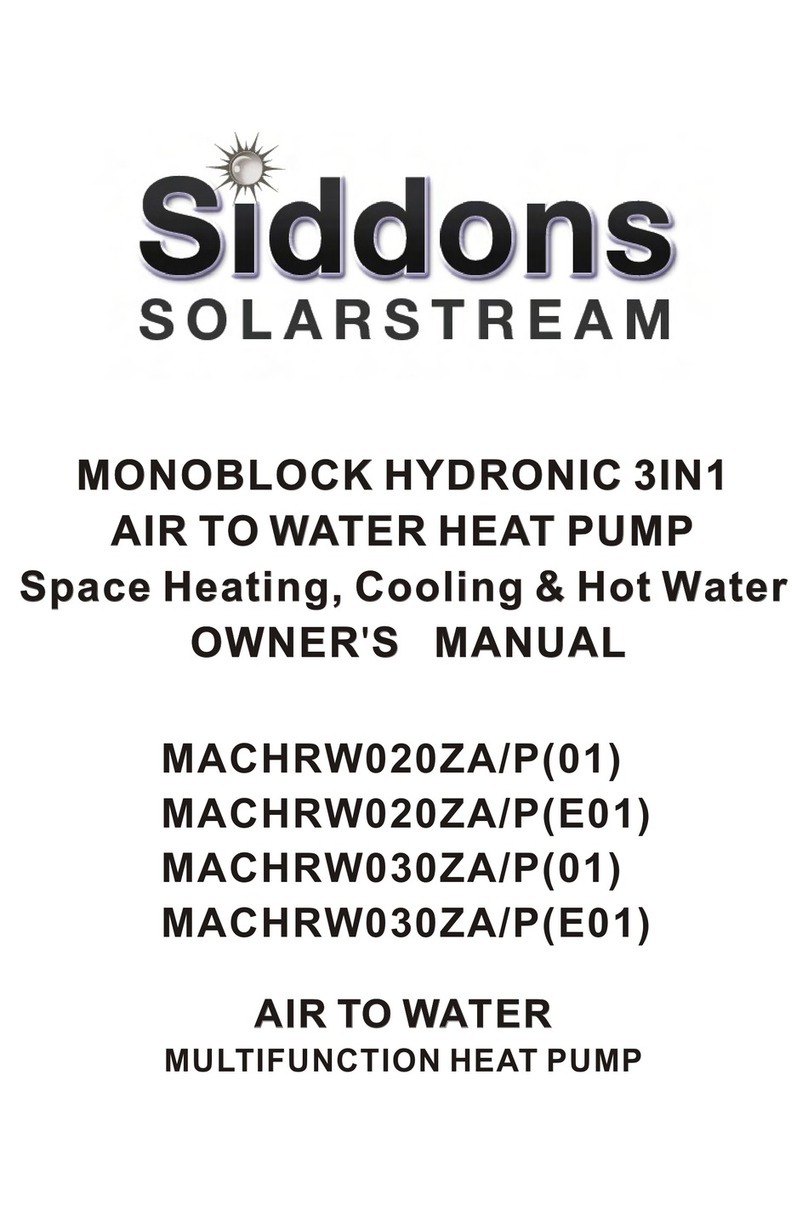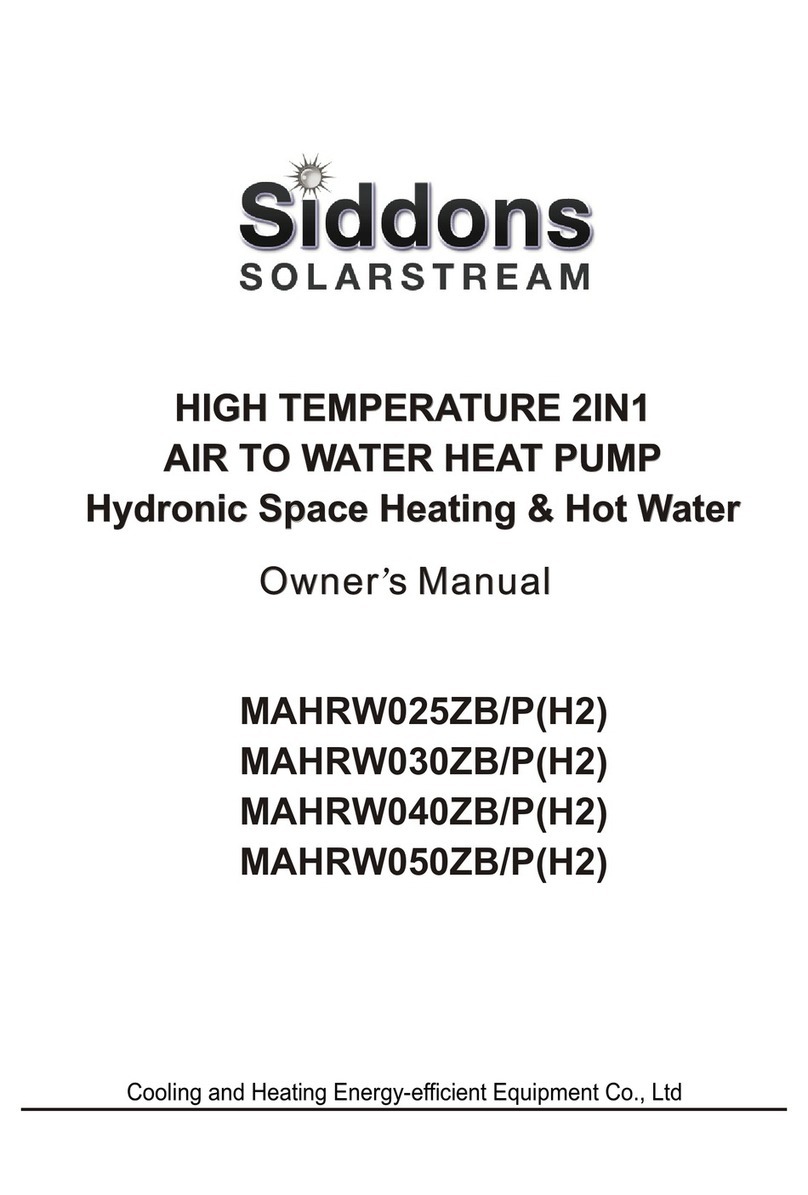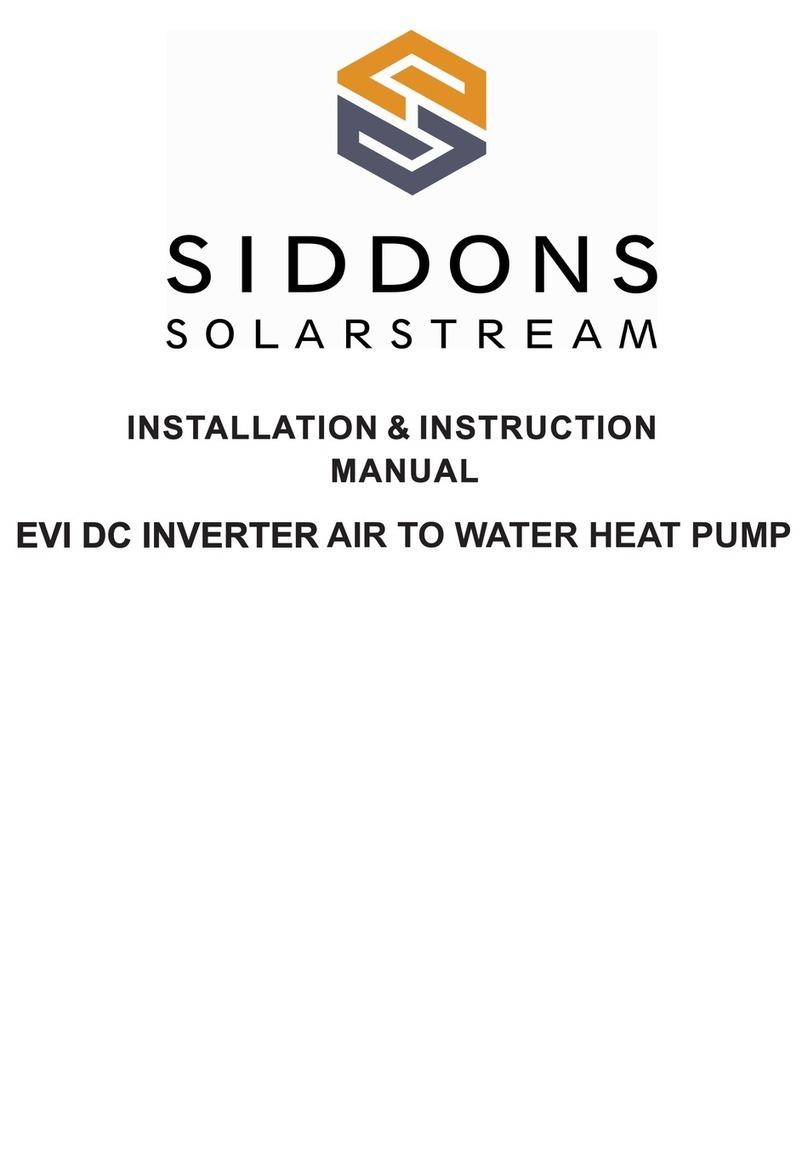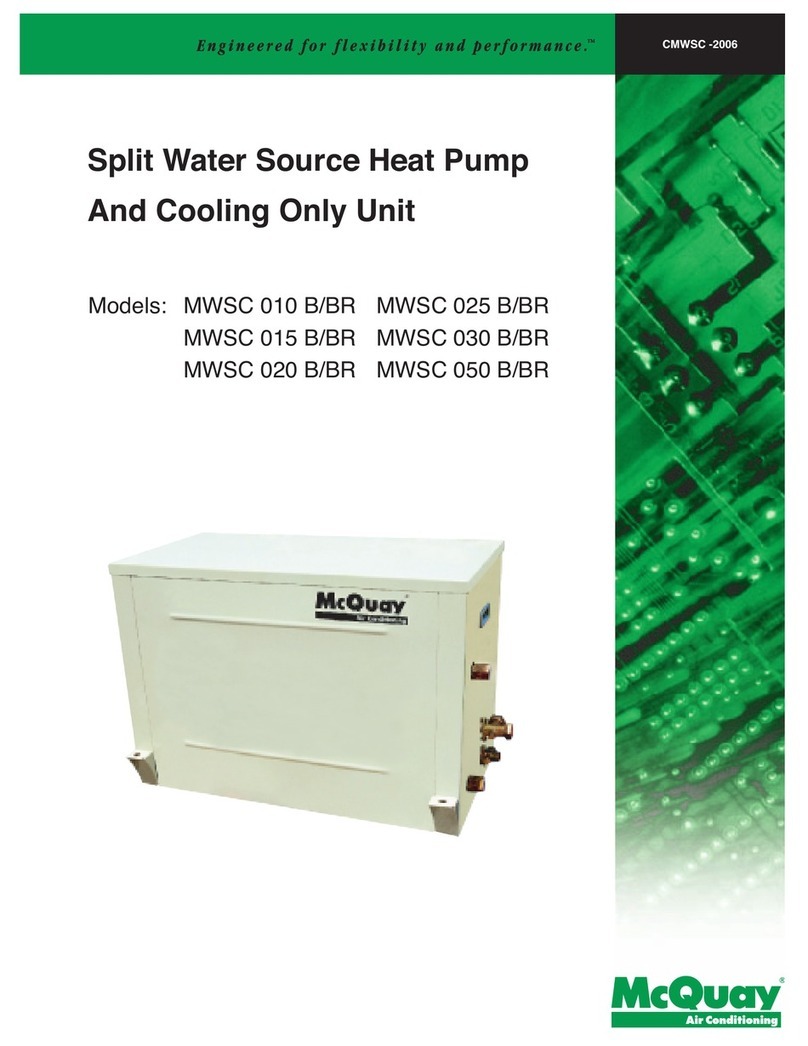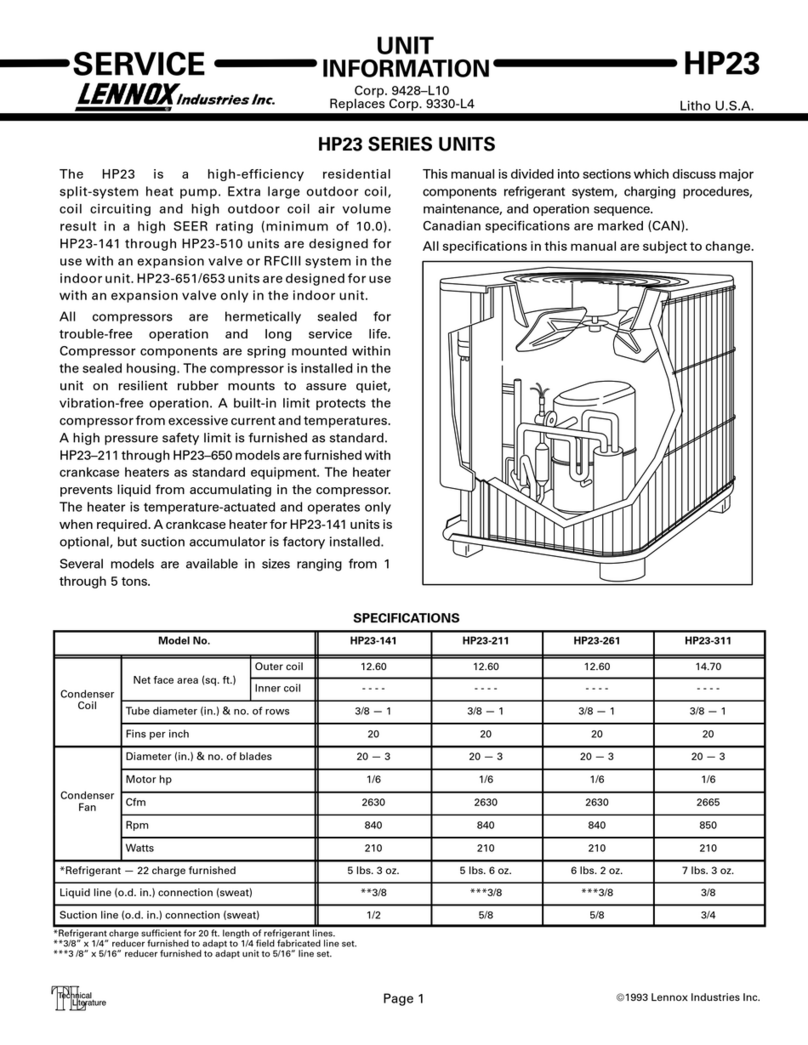Siddons Solarstream MAHRW015WAA User manual

www.siddonssolarstream.com
To be read in conjunction with the
Installation and User Manual for models:
ELECTRONIC SPLIT HEAT PUMP
OWNER'S MANUAL
For externally coiled tanks with
refrigeration line connections
Model MAHRW015WAA
AIR TO WATER HEAT PUMP
264SSAD, 264SSBD
327SSAD, 327SSBD

Notice
1.1 Save this manual for future reference.
1.2 In order to use this product better and more safely, please read this manual carefully before
installation and initial operation.
1.3 Children or persons with physical, sensory or mental disability should not play with nor operate
this appliance.
1.4 This appliance must be installed by qualified and experienced technicians/tradespeople.
Improper installation of this appliance may cause damage and danger.
1.5 This appliance must be installed in accordance with Australian wiring regulations including an
isolating switch from the supply mains and grounded power supply consistent with the power
requirements of this appliance.
1.6 The installation of this appliance must comply with the model's wiring chart in this manual and
its power requirements as stated on the rating label on the side of the heat pump.
1.7 Do not install this appliance close to flammable or explosive materials, or naked flames.
1.8 A filter in the mains water supply inlet is recommended and should be checked/cleaned
periodically.
1.9 Checking and cleaning of the evaporator fin coil is recommended for good air flow.
1.10 The battery should be removed from this appliance's controller at the end of its operating life
and disposed of safely.
Content
1
1
1
1
2
2
3
7
4
4
4
5
5
5
5
5
6
10
12
13
I. Specification........................................................................
1. How it works................................................................................
2. Stainless Steel Hot Water Storage Tank.........................................
3. Flexible installation......................................................................
II. Electronic Split Heat Pump..................................................
1. Technical parameters for the main unit...........................................
2. Electronic Split Heat Pump Dimensions .........................................
3. Heat Pump check .........................................................................
III. Technical Guide..................................................................
1. Starting Current and Peak Current.................................................
2. Electrical wiring...........................................................................
3. Gas Levels and Pressures.............................................................
4. Electronic expansion valve............................................................
IV. Digital Controller................................................................
1. Operation & Adjustment of the Digital Controller..............................
2. Use of Digital Controller....................................................
3. Operation date setting...................................................................
V. System Malfunction Schedule..............................................
VI. Wiring diagram .. .......................................................... ......

RETROFITTING TO AN EXISTING SIDDONS COILED TANK
This new Electronic Split heat pump model has improved features over the previous mechanical heat pump.
New features include:
* Electronic tank sensor probe replacing the mechanical Klixon tank thermostat for regulating the on/off
function of the heat pump
* Electronic tank sensor probe replacing the mechanical Klixon tank thermostat for regulating the over
temperature function of the compressor; this can be reset by turning power to the heat pump on/off.
* Electronic tank sensor probe for activating the de-ice function; on older units from 2005, this will replace
the mechanical Klixon evaporator thermostat for regulating the de-ice function
* Pressure switches
* LED display unit that provides diagnostic information and monitoring of key operating parameters (refer
Section IV). Note, the LED display unit can be placed under the heat pump lid on top of the electrical
wiring post or placed onto a wall using the sensor extension lead provided with the heat pump)
REFRIGERANT: This Electronic Split heat pump is charged with 1.5KG of R134A refrigerant, whereas the
older style Mechanical Split heat pump is charged with 1.5kg of R417a refrigerant.
CONNECTING THE NEW HEAT PUMP
* Locate the heat pump at least 75mm clear of a wall on the air inlet side and at least 1m clear of a wall or
fence on the air outlet side.
* Ensure all refrigerant is purged from the existing system.
* Connect the existing refrigeration lines to the new refrigeration lines supplied with new electronic heat
pump by brazing them together.
* Ensure the new heat pump and tank and connected with no refrigerant leakage.
* Evacuate the air from the refrigeration lines and the 40m condenser coil wrapped around the tank.
* Fully open both refrigeration valves on the heat pump to charge the whole system.
* Mark the technical label on the tank, deleting reference to R417a refrigerant charge and write in R134a.
* The digital controller can be placed inside the heat pump box on top of the terminal block after the heat
pump has been set, clock and timer (if required) or it can be fixed onto a wall by using the extension lead
provided. Make sure the digital controller is protected from the weather.
* Fit the drain plug and connect a plastic hose to take the condensate water from the evaporator away to a
drain from underneath the heat pump. Angle the heat pump slightly towards the drain plug to enable the
condensate water to flow easily towards the drain plug. Periodically check the drain plug for any blockages.
* If the heat pump is mounted on a wall or on top of a roof, make sure the heat pump’s feet are mounted on
top of rubber pads to prevent vibration from being transmitted.
* It is fine to connect the heat pump to off-peak power but keep in mind the heat pump will operate about
25% more efficiently with a 10 degree rise in the ambient air temperature.
* We recommend installing a pool pump timer set between 12:00pm and 5.00pm if connecting to a
continuous tariff to ensure one operating cycle at the warmest time of day for greater efficiency.
CONNECTING THE SENSOR PROBE TO THE TANK
You will need to fit the tank water temperature sensor probe against the storage tank wall, underneath the
insulating foam and seal with silicone. Here are the key installation points:
* Make a small hole with a screwdriver hard against the storage tank 50-75mm long to fit the probe tightly
* Push the sensor probe in right to the end of the hole
* Seal the hole with silicone to ensure the probe gets a good reading from the tank wall, unaffected by the air
* Secure the sensor probe lead so it cannot fall out of position
* Fine tuning adjustment to the probe cut off/on settings can be made if necessary (refer Section IV)

I¡General
1
2. Hot Water Storage Tank
1. How it works
3. Flexible installation
The condenser coil for the Siddons Solarstream model MAHRW015WAA, with 1.5 horsepower
rotary compressor, is designed to operate with a 40m x 3/8inch copper condenser coil wrapped
around a stainless steel storage tank, insulated on the casing side with at least 50mm of foam
insulation and conductive on the water side, or equivalent. The coil should either be tightly
wrapped around the storage tank or an equivalent internal coil can be used if the inlet water has low
mineral content, typically water coming from reservoir from a mountain catchment, such as exists
in Tasmania, Melbourne, Canberra and Sydney. For other locations, check with your local plumber.
The split system allows flexible design options and with the storage tank installed inside or outside.
It is best for the heat pump to be installed outside and made accessible for any maintenance. Also
the outlet fan should have at least 1m unimpeded distance for the air to blow out.
Installations may vary from the side by side configuration of heat pump and water tank to placement
of the heat pump up to 9 metres distant from the water tank including up to 3 metres above such as
installation of the heat pump on a roof with water tank on the ground.
The Heat Pump comes pre-charged with 1.5kg of ozone friendly R134a refrigerant. This is sufficient
to charge a side by side system with 2m connection lines after it has been connected. For Heat
Pumps installed with extension lines, the refrigerant charge should be slightly greater than 1.5kg,
allow 30 grams extra per additional metre to ensure the correct refrigeration charge in the system.

2
MODEL
COOLING
HEATING
RATED CAPACITY
RATED CURRENT
RATED POWER INPUT
EER
STAR RATING
HEATING CAPACITY
RATED CURRENT
RATED POWER INPUT
EER
STAR RATING
W
A
W
WW
W
A
W
WW
MAHRW015WAA
3500
4.7
1080
3.15
3500
4.5
1020
3.2
4.5
4
POWER SUPPLY
MAX OPERATION CURRENT
NOISE LEVEL INDOOR/OUTDOOR
VOLUMETRIC CAPACITY
DEHUMIDIFICATION CAPACITY
REFRIGERANT TYPE/CHARGE
Ph/V/Hz
A
dB(A)
3
m /h
L/h
/(g)
1/~220-240/50
10.2
53
620
1.5
R134a /1500(g)
INDOOR/OUTDOOR UNIT
DIMENSION (mm)
NET WEIGHT INDOOR/OUTDOOR
COMPRESSOR TYPE
LCD REMOTE CONTROL
TEMPERATURE SETTING RANGE
OPERATION MODES
FAN SPEEDS
24-HOUR ON/OFF TIMER
W
D
H
Kg
Liquid
Gas
¡
780
258
540
Kg 10/40
CONNECTION PIPE SIZE mm(inch)
COMPRESSOR TYPE
LCD REMOTE CONTROL
TEMPERATURE SETTING RANGE
OPERATION MODES
FAN SPEEDS
24-HOUR ON/OFF TIMER
UP/DOWN LOUVER
LEFT/RIGHT LOUVER
HI-POWER
SLEEP MODE
DRY MODE
LED DISPLAY ON FRONT PANEL
LIQUID
GAS
6.35(1/4)
9.52(3/8)
Rotary
Y
OC16-30
4
3
Y
Automatic
Manual
Y
Y
Y
Y
2
M
model
brand
TB36G
Mitsubishi
SOFT START
APPLICATION AREA*
Compressor
N
18-30
1. Technical parameters for the main unit
II Electronic Split Heat Pump

A
B
C
D
Size
Units: mm
MAHRW
280
505
805
542
B
A
C
D
015WAA
2. Electronic Split Heat Pump Dimensions
The heat comes apart easily. Firstly remove the lid, then unscrew the brace on
top of the fan to the front panel, then the screws along the base of the casing
working from the front RHS corner along the base to the left to the back plate
on the opposite corner. Unscrew the two screws connecting the back plate.
3

4
3. Heat Pump checks
Flare Nuts
Ensure the flare nuts are tight, use two spanners and apply pressure, one spanner countering
the force of the other.
Compressor Sitting Squarely
This image shows the Heat
Pump without the casing
revealing the compressor.
Note the compressor sits in a
tray under its own weight and
can occasionally shift its
alignment during transit and/or
installation.
If there is any metallic vibrating
or rattling sound present, try
shifting the compressor with
your hands to ensure it squarely
seated in the tray.
III¡Technical Guide
1. Starting Current and Peak Current
When the Heat Pump starts up for the first time, when the tank has cold water, the power
input will be approximately 700 watts / 220 volts = 3.1 amps. The current will gradually
rise over the heating cycle until it reaches the maximum power input of 1.38kW/230
volts = 6.2 amps, just before the thermostat cuts out the Heat Pump compressor. The
power input ranges between 0.8kw to 1.38kW, 1.1kW average, and will produce Heat
Output of 3.3kW at 20 deg C and 4.4kW at 30 deg C ambient temperature at lower humidity.

The unit should use dedicated power supply and power supply voltage line corresponding with rated
voltage, 220-240 volts. The power cable must be a copper cable, the cable diameter must be sufficient for the
maximum starting current of around 26 Amps.
The unit power supply circuit must have a grounding wire, which should connect with a reliable
external ground wire, and the external ground wire is effective. Wiring construction must be installed
by professional technicians refer to circuit diagram.
Power lines and signal line layout should be neat, rational, strong and weak lines separate and can
not interfere with each other, while not contacted with the connecting pipe and the valve body.
When power lines and control lines parallel, the wires were placed in each tube, also leave appropriate
distance between the lines.
Heat Pump electrical wire connection: take the power line, remote control three core lines, and water
tank temperature sensor probe, and pass themthrough the wiring hole set into the electrical box, then
connect to the appropriate terminals according to wiring diagram.
Unit control panel Code MK4068, Fuse specifications: 5A/250V.
Electric wire selection
2. Electrical wiring
220V/1PH/50Hz 1.0 2
mm 1.0 2
mm 1.0 2
mm 0.5 2
mm 0.5 2
mm
Host power
Mode Phase line Zero line Ground line Max.line
length (m) Signal line Tem. Sensor
Max.line
length (m)
MAHRW015WAA
15 50
Notes:
1). Use PVC insulated copper wire for above wiring
2). If the line is longer than the maximum line length, please contact Siddons.
5
3. Gas Levels and Pressures
For a standard side by side system, the heat pump is pre-charged with 1.5 kg of R134a refrigeration.
The high pressure hot gas line will start at around 1,100 kPa at 20 deg C and lower in colder
temperatures, such as 900kPa at 10 deg C, and reach around 2,600 kPa at cut out temperature
(60 deg C water temp) irrespective of the ambient temperature.
4. Electronic expansion valve
The electronic Split heat pump has an electronic expansion valve which will automatically control
the refrigerant flowrate, adjusting therefrigeration system to work optimally in all ambient air
conditions and through the heating cycle by constantly adjusting the refrigerant flow rate.
1. Operation & Adjustment of the Digital Controller
Caution:
Apart from adjusting the time, timer, hot water temperature or restart dead-band settings,
only an authorised technician should make adjustments to the other parameters depending
on local climatic conditions and usage circumstances, or as instructed by SIDDONS.
IV Digital Controller

6
2. Use of Digital Controller
1.1 Optional Mounting and Fixing of the Remote Controller:
2.1 User Interface and Functions:
Heat pump on/off
button
Operating status
SET
IN
NO
ROOM
OUT
VALVE
ELEC
TEMP
HUM
1
2
FAN
C
%
C
%
Buttons lock icon
CLOCK T IMER
Defrost Mode (continuous flashing)
Water heating mode
Manual water supply flow and return mode
(flashing)
Automatic water supply flow and return
mode (on but not flashing)
Electric heater mode - N/A
Timer 1 (heat pump on/off timer setting)
Timer 2 ( water supply flow and return mode
on/off timer setting)
Manual electric heater
on/off button - N/A
Open the controller
(push tabs in)
Timer setting button
Clock setting button
Water cooing mode - N/A
Additional water pump - N/A
Heat pump fan only - N/A
The remote controller is designed for standard wiring and to fit a standard electrical box
with dimensions 86 x 86mm, fixed hole distance 60mm. The illustration below shows how
to open and fix the controller and base box. You may request from SIDDONS extension
wiring for the remote controller and a blank panel to fit onto the casing after relocating the
controller.
Complete the installation by pressing the
digital controller down firmly to reengage
the tabs.
Put the digital controller into the base box and
tighten the two setting screws.
Illustration 3
Illustration 4
Illustration 1
Illustration 2
Use a flat screwdriver to press down the two
tabs and lift open the face covering.
Remove the top covering leftwards to
disengage two top tabs.

7
2.2 Initial Power On and Standby Status
After first powering on, the remote controller will show the full screen display. After 10 seconds, it will
show the Standby status with storage tank temperature, ambient air temperature and clock showing.
Initialization status
CC
ELEC
CLOC K TI ME R
Standby status
2.3 ON/OFF Control
ON/OFF button. Press this button to power on and off. In the ON mode, the remote controller
displays the operation mode, clock, timing status, bottom of water tank temperature and ambient temperature.
Notice: When the heat pump is turned on for the first time, the default 3 minute delay is not operational,
but will revert from the second time it is turned on.
Hot water
tank temperature
Ambient
temperature.
CC
ELEC
CLOC K TI ME R
OUT
OUT
2.4 Electric Heater Control
NOTE: The electric heater control is not applicable to Australian BOLT-ON Heat Pump models.
A: Independent electric heater mode:
Under the turn off status, press the button, you can turn on the independent electric heater mode the
sign of display on the interface like the picture 1. press the button again turn off the independent
electric heater mode like the picture 2.
B: Auxiliary electric heater mode:
Under the turn on status, press the button, you can turn on the auxiliary electric heater mode, the sign
of display on the interface like the picture 1. When the delay time which is begin when you turn on the
unit is longer than the parameter of 3 setting, the electric heater signal will output. Press the button again
turn off the auxiliary electric heater mode like the picture 2.
ELEC
IN
CC
ELEC
CLOC K TI ME R
IN
CC
CLOC K TI ME R
picture 1 picture 2
IN
CC
ElEC
CLOC K TI ME R
IN
CC
ElEC
CLOC K TI ME R
picture 1 picture 2
ELEC
ELEC
ELEC
OUT OUT
OUT OUT
ELEC
NO
ROOM
OUT
VALVE
1
2
C
%
C
%
CLOC K TI ME R
IN
ELEC
SET
TEMP
HUM
FAN

8
2.6 Clock Setting
Under power-on or stand by status, press to adjust the clock. The hour and minute display
flickers. Press again and the hour display flickers. Use to adjust the hour. Press
again. The minute display flickers. Use to adjust the minutes. Press again to
quit clock adjustment.
CLOCK
ELEC
CLOC K TI MER CLOCK T IM ER
CLOC K TI MER
2.5 Turning On/Off the Ring Main Water Circulating Pump Manually.
Press the button for 5s to turn on the water supply pump. The sign will display on the
interface as in picture 1. Press the button again to turn off the water supply pump as in picture 2.
IN
CC
ELEC
CLOC K TI MER
IN
CC
CLOC K TI MER
picture 1 picture 2
OUT OUT
OUT OUT OUT
1
ROOM
1
ROOM
1
ROOM
1
ROOM
1
ROOM
1
ROOM
1
ROOM
ELE C
CLOCK
TIMER
CLOCK
TIMER
CLOCK
TIMER
CLOCK
TIMER
CLOCK
TIMER
CLOCK
TIMER
CLOCK
TIMER
2.7 Timer 1 ON/OFF Setting
Press button for hour, minutes and timing. The ON symbol flickers. Press again, the
hour display flickers. Press the button to adjust the setting of the hour. Press button
again, and the minute display flickers. Press buttons to adjust the minutes. Press
button again and the hour and timer OFF symbol flickers. Press again and the hour display
flickers, press button to adjust the hour setting. Press button again, and the minute
display flickers. Press buttons to adjust the minute setting. Press button to exit the
timer ON/OFF setting. The following example shows the heat pump set to turn on at 8:30 every
morning, and turn off at 23:30 every night (Timer 1 turns the heat pump ON/OFF).
TIMER TIMER
TIMER
TIMERTIMER
TIMER
TIMER
ELEC
ELEC EL EC
ELE C EL EC ELE C ELE C ELE C ELE C
CLOCK
CLOCK
CLOCK
CLOCK CLOCK
2.8h Timer 2 ON/OFF Setting
Press for 5s to adjust the hours and minutes setting. The ON symbol flickers. Press again,
the hour display flickers. Press the button to adjust the setting of the hour. Press button
again, the minute display flickers. Press buttons to adjust the minutes. Press
button again and the hour and timer OFF symbol flickers. Press again and the hour display
flickers, press button to adjust the hours. Press button again and the minute display
flickers. Press buttons to adjust the minutes. Then press button to exit the timer ON/OFF
setting. The following example shows the heat pump set to turn on at 8:30 every
morning, and turn off at 23:30 every night (Timer 1 turns the heat pump ON/OFF).
TIMER TIMER
TIMER
TIMER
TIMER
TIMER
TIMER

9
2
ROOM
2
ROOM
2
ROOM
2
ROOM
2
ROOM
2
ROOM
2
ROOM
2.9 Cancellation of Timer Setting Operation
Press button, then press button to cancel Timer 1.
Press for 5 seconds, then press button to cancel Timer 2.
2.10 Parameter Setting
In the standby mode, press at the same time to interface with the parameters 0-17 and A-G.
Choose the parameter you want to modify, then press and at the same time to change the
parameter setting, then press at the same time to modify the parameter value, then press
and at the same time to confirm the modification.
Note: 1. The parameters can not be modified in boot-up mode. They need to be modified
in standby mode.
2. If you stop operations for 10 seconds, you will quit the parameter setting mode.
ELEC
ELEC
CLOCK
TIMER
CLOCK
TIMER
CLOCK
TIMER
ELEC
Parameter 4
Not applicable on this
model
Parameter 3
Not applicable on this
model
Parameter 2
Not applicable on this
model
Parameter 1
Compressor restart
dead-band differential
temperature range.
Range: 2¡ to 15¡.
Default: 12¡
Parameter 0
Hot water tank temperature
Range: 10¡ to 60¡.
Default: 60¡
Note: temperature rise above
sensor probe approx 5¡
Parameter 9
Defrost time maximum time
Range: 1 to 12 min.
Default: 8 min
Parameter 8
Defrost exit temperature
Range: 2¡ to 30¡.
Default: 13¡
Parameter 7
Defrost enter temperature
Range: -30¡ to 0¡.
Default: -7¡
Parameter 6
Defrost cycle time out
Range: 30 to 90 min.
Default: 45 min
Parameter 5
Not applicable on this
model
Parameter 13
The electric expansion
valve operation step setting
for the manual control style
default setting :35
(measure valve=35*10)
Parameter 12
Electronic expansion valves
control the selection
0:mannual control
1:automatic control
default setting:1
Parameter 11
The Target superheat
temp. Alternative
range:-F(-15)¡ to F(15)¡.
default setting:5¡
Parameter 10
Not applicable on this
model
CLOCK
TIME R
ELEC
CLOCK
TIME R
ELEC
CLOCK
TIME R
ELEC
ELEC
CLOCK
TIMER
ELEC
CLOCK
TIMER
ELEC
CLOCK
TIMER
ELEC
CLOCK
TIMER
ELEC
CLOCK
TIMER
ELEC
CLOCK
TIMER
CLOCK
TIME R
ELEC
CLOCK
TIME R
ELEC
CLOCK
TIME R
ELEC
CLOCK
TIME R
ELEC
CLOCK
TIME R
ELEC
CLOCK
TIME R
ELEC
CLOCK
TIME R
ELEC
CLOCK
TIME R
ELEC
CLOCK
TIME R
ELEC
CLOCK
TIME R
ELEC
CLOCK
TIME R
ELEC
Parameter 14
Unloading valve type
Alternative range:-15(-F) to
-14(-E)
Default: -F
CLOCK
TIME R
ELEC

10
Parameter16£The ambient
temp.setting for the unit
enter the ambient temp.
Too low protection
Alternative range:
-30¡ to 0¡Default: -15¡
(The minus sign can not
display)
Parameter B£Water
outlet temperature
Parameter A£Hot water
tank temperature
Range: -9¡ to 99¡
Actual testing value
Parameter C£
System coil temperature
Range: -9¡ to 99¡
Actual testing value
Parameter D£
System suction
temperature
Range: -9¡ to 99¡
Actual testing value
Parameter E£
Not applicable on this
model
Parameter F£
Ambient temperature
Range: -9¡ to 99¡
Actual testing value
Parameter G£
The electric expansion valve
opening Range: 15*10¡35*10
Actual testing value
Parameter17£The paramter
is set for recovering
refrigerant or adding
refrigerant
0:The unit normal running
1:The unit enter recovering or
adding refrigerant mode
Default: 0
¢
Note: After recovering refrigerant or adding refrigerant,you must reset the paramter 17 to 0,or else the unit
can not heating.
¢
£
The hot water tank temperature setting
of auxiliary electric heater mode
The temp. of start high-temperature
disinfection per week setting
10 60
2 15
10 90
0 90 min
60 90
0 90 min
30 90 min
-30 0
2 30
1 12 min
1~20
-F(15) F(15)
15*10 35*10
60
12
55
30 min
70
30 min
45 min
-7
13
8 min
6
5
1
(35*10)
Defrost cycle setting
Enter defrost temperature setting
Exit defrost temperature setting
Exit defrost max. time cycle setting
High-temperature disinfection maintain time
Tank temperature difference value for the
compressor restart setting
Domestic hot water tank temperature setting
The unit's operation data can be set on the wire controller.
Please set according to the table below.
3. Operation Data Setting
0
1
2
3
4
5
6
7
8
9
10
11
12
13
Parameter Content description range default Adjust
Adjustable
Adjusted by technicians
Not applicable
Not applicable
Not applicable
Not applicable
Adjusted by technicians
Adjusted by technicians
Adjusted by technicians
Adjusted by technicians
Not applicable
Adjusted by technicians
Adjusted by technicians
Adjusted by technicians
Electric heating start time delay the
time after the unit turn on
1
1
1
The electric expansion operation step setting
for the electric expansion manual control style
Difference temp. Value between solar
and tank for Solar pump start setting
The target superheat temperature setting
for the electric expansion valve.
The control style selection of the electronic
expansion valve
¢
0: manual control
1:automatic control
Alternative range: -9¡ to 99¡
Actual testing value
CLOCK
TIME R
ELEC
CLOCK
TIME R
ELEC
CLOCK
TIME R
ELEC
CLOCK
TIME R
ELEC
CLOCK
TIME R
ELEC
CLOCK
TIME R
ELEC
CLOCK
TIME R
ELEC
CLOCK
TIME R
ELEC
CLOCK
TIME R
ELEC
Parameter15£
Water tank temp.
Supplement setting
CLOCK
TIME R
ELEC

11
-30 ~0
15
16
17
A
B
C
D
E
F
G
Adjusted by technicians
Adjusted by technicians
Actual testing value
Actual testing value
Actual testing value
Actual testing value
Not applicable
Actual testing value
Actual testing value
Hot water tank temperature
Water outlet temperature
System coil temperature
System suction temperature
Solar collector temperature
Ambient temperature
-9 99
-9 99
-9 99
-9 99
-9 99
-9 99
15*10 35*10
The ambient temp.setting for the unit enter
the ambient temp.too low protection
¢
Note:
: Applies to the heat pump with Aux. electric heater.
: Applies to the heat pump with Solar collector. Not applicable.
: The minus sign can t display.
If you stop operating the controller for 10 seconds, it will log out automatically.
The electric expansion valve opening
0: normal running
1: recover or add refrigerant
0
The paramteris set for recovering old
refrigerant or adding new refrigerant
The ambient setting for the ele.c expansion
valve turn back to the manual control style
Water tank temp. supplement setting
14
15
Adjusted by technicians
Not applicable
1
3
2
-F(15) 30
-15(-F) -14(-E)
0
-F

12
V. System Malfunction Schedule
Check for lack of water or air in the cycle heating system heat
exchanger and discharge the air. Check if the water temperature is
too high. Check if the refrigerant charge is too great. Check whether
the high pressure switch has been damaged.
EE1
EE2
EE3
EE4
Check for lack of refrigerant. Check whether the low pressure switch
has been damaged or wire has become disconnected.
System high pressure
protection
System low pressure
protection
Aux.electric heater
overheat protection
Check whether communication wires have been disconnected or
there is a connection error.
EE8
Check whether the power supply is normal. Check whether the
current is greater than normal. Check whether the a/c contactor
connection is normal.
System is running in defrost mode.
Power phase
sequence protection
Communication failure
Not applicable
Unit defrosting status
١. Check whether the temperature thermistor of the upper part of
the water tank is connected loose or not .
upper part٢. Connect temperature thermistor of the of the water
tank tight or change the temperature thermistor.
١. Check whether the temperature thermistor of the is connectedcoil
loose or not .
٢. Connect temperature thermistor of coil tight or change the
temperature thermistor.
١. Check whether the exhaust temperature thermistor is connected
loose or not .
٢. Connect exhaust temperature thermistor tight or change the
exhaust temperature thermistor.
١. Check whether the ambient temperature thermistor is connected
loose or not .
٢. Connect ambient temperature thermistor tight or change the
ambient temperature thermistor
١.Check whether the temperature thermistor of the bottom of the
water tank is connected loose or not .
٢.Connect temperature thermistor of the bottom of the water tank
tight or change the temperature thermistor.
PP5
PP6
PP1
PP2
PP3
Malfunction and
Protection Name
Fault
code Solution
Hot water tank
temp. Sensor failure
Water outlet
temp.Sensor failure
System coil temp.
Sensor failure
System suction
temp. sensor failure
Solar collector
temp. sensor failure
Ambient temp. sensor
failure
PP4
Normal start
Standby
PP7 Water flow protection
1:Check for lack of water or air in the cycle heating system heat
exchanger and discharge the air.
2:Check whether the Grundfos water pump is working.
1. Check whether the resistor or temperature thermistor of the solar
collector is connected loose or not .
the solar 2. Connect resistor or temperature thermistor of the
collector tight or change the temperature thermistor.

VI¡Wiring diagram
Wiring diagram MK4068-0101 for Electronic Split model MAHRW015WAA
Wiring diagram MK4068-0101
Legend:
VA1: 4-way valve
VA2: Electric expansion valve
LP1: System low pressure switch
HP1: System high pressure switch
SW1: Power phase sequence
protection switch(close circuit)
SW2:Water flow switch(close circuit)
: 4 way valve coil
: Wire controller
SW3:Unit turn on/off switch(close circuit)
Fp1: Auxiliary electric heater
overload protection switch(close circuit)
T1 : Hot water tank temperature
T2 : 5K resistor
T3 : System coil temperature
T4 : System suction temperature
T5 : 5K resistor
T6 : Ambient temperature
AC-N
CN1
CN2
OUT3 OUT4 OUT5 OUT6
OT1
OT2
CN3
CN4
OUT7
Power input
(220V/1PH/50Hz)
R
C
S
×
White
OUT8
01
2 9
2 8
2 7
2 6
2 5
2 4
2 3
2 2
2 1
2 0
1 9
1 8
Red
Brown
Capacitance
G/Y
Black
Fan
Blue
G/Y
White
Red
Comp
L N
Brow n
Blue
Yell ow
Transformer
02 03 04 05 06 07 08 09 10 11 12 13 14 15 16 17
T1
SW1
T
FP1
LP1
HP1
SW2
SW3
T
T
T
T
T
T2 T3 T4 T5 T6
CN19
VA2
VA1
Red
Blue
Blue
Capacitance
13

MACON
AIR TO WATER HEAT PUMP
CODE:MK4068-01
Table of contents
Other Siddons Solarstream Heat Pump manuals
Popular Heat Pump manuals by other brands
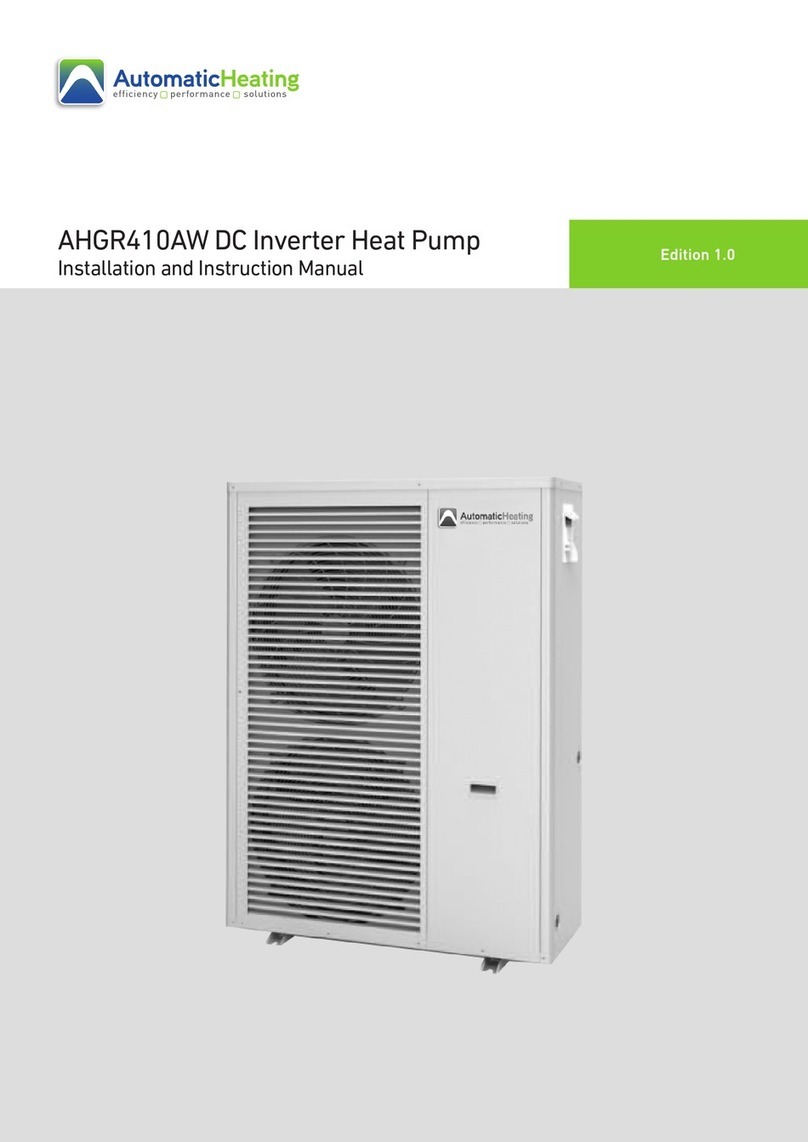
Automatic Heating
Automatic Heating AHGR410AW Series Installation and instruction manual
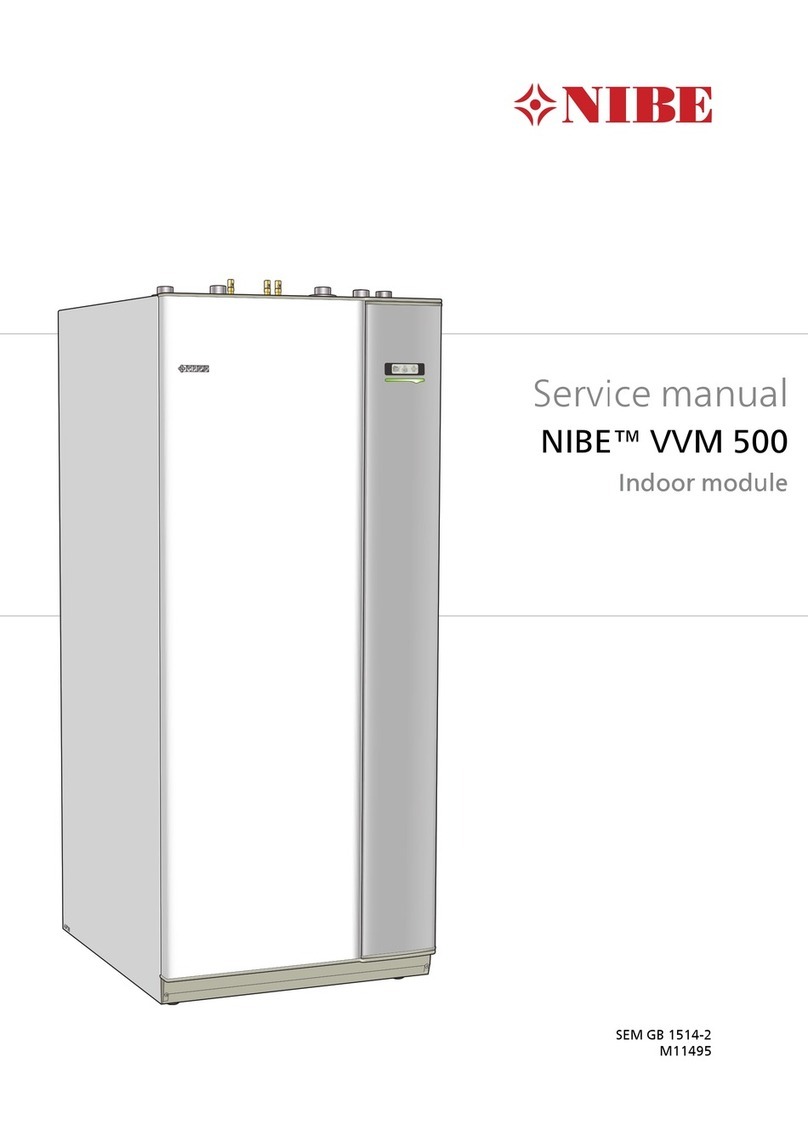
Nibe
Nibe VVM 500 Service manual

Rheem
Rheem RP14 14 SEER installation instructions

Trane
Trane 4TWR5018E Installer's guide
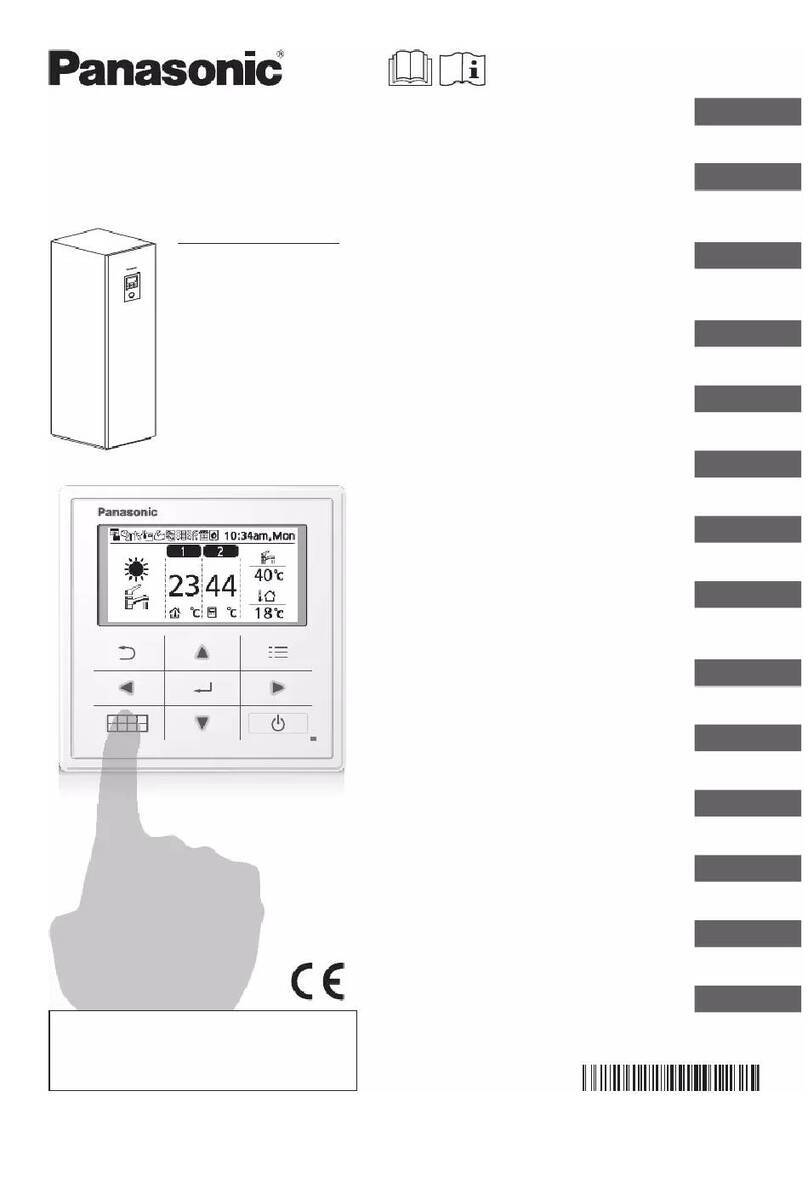
Panasonic
Panasonic Aquarea WH-ADC0916H9E8 manual
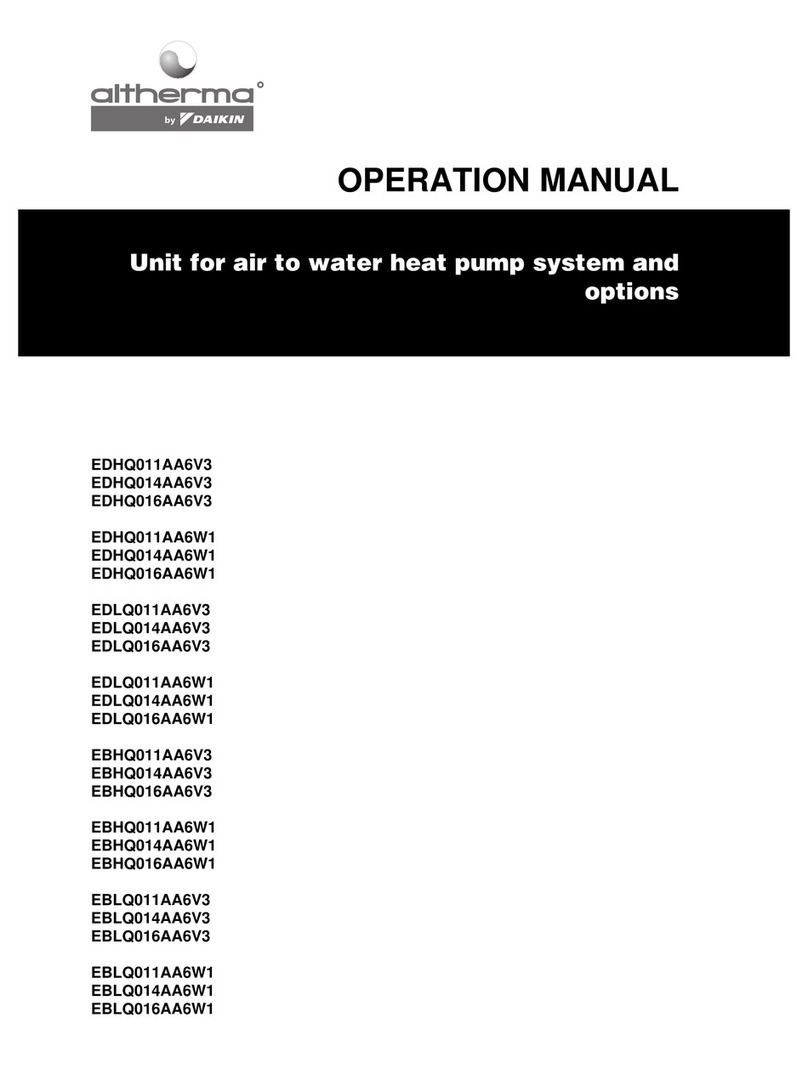
Daikin
Daikin Alterma EDHQ011AA6V3 Operation manual
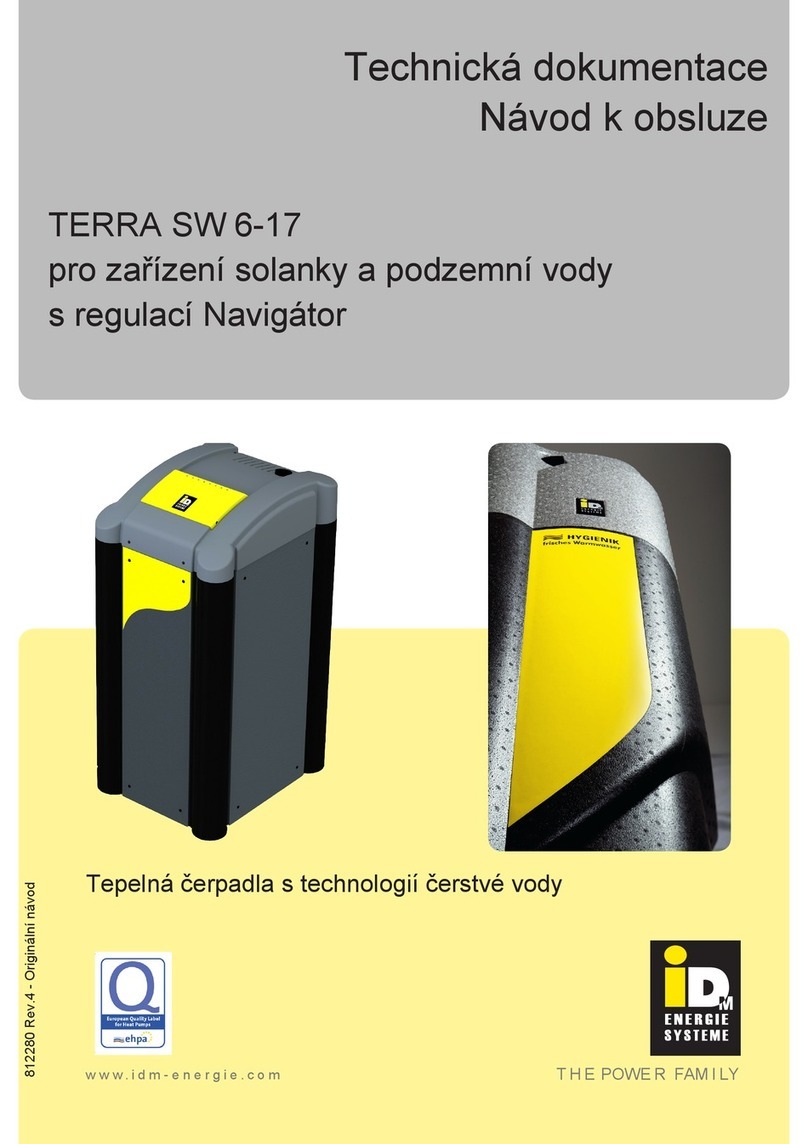
iDM
iDM TERRA SW Series Technical documentation, service manual
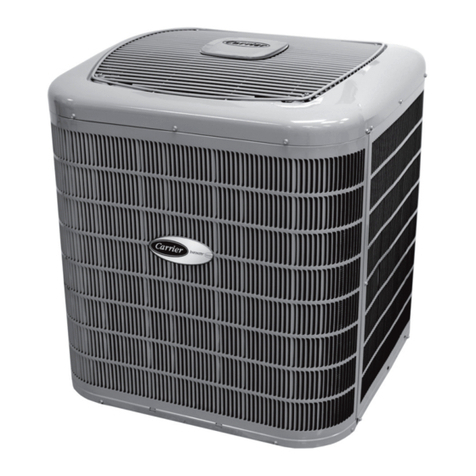
Carrier
Carrier 25HNB5 installation instructions
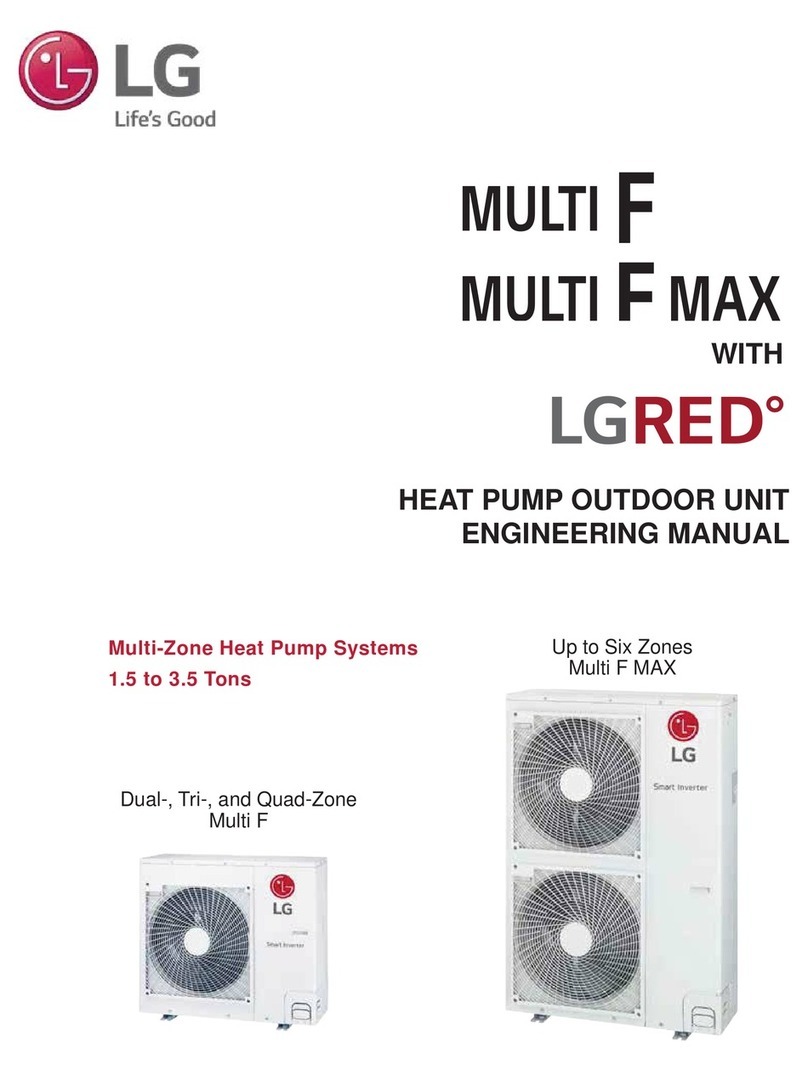
LG
LG MULTI F MAX Engineering manual
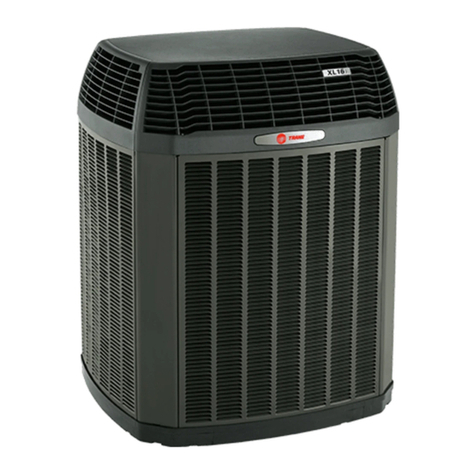
Trane
Trane WEATHERTRON 4TWX6 Use and care

Carrier
Carrier AQUAZONE 50PCH Installation and service instructions

Supreme Heating
Supreme Heating Heatseeker NovaS Installation & user manual
